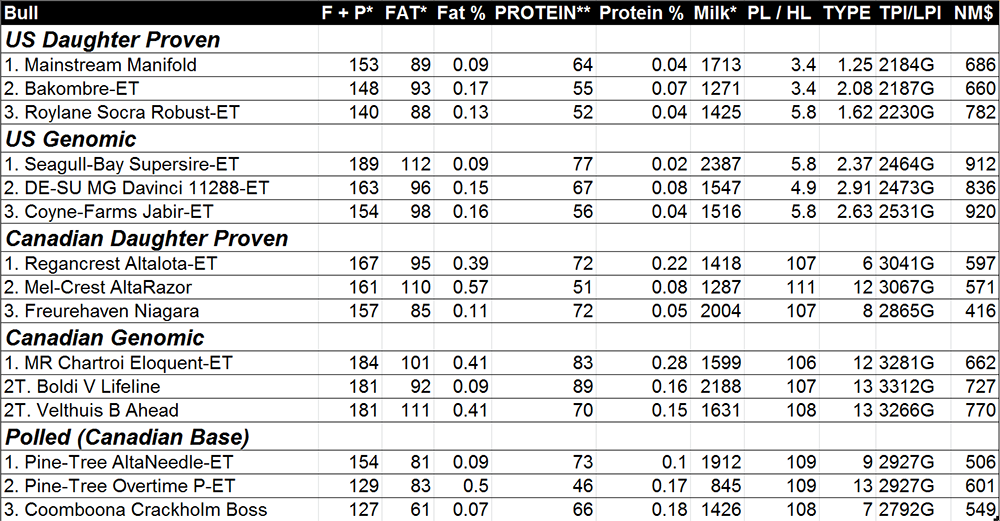Over the past couple of weeks the Bullvine has published articles about having a breeding plan for your herd. (Read more: Flukes and Pukes – What Happens When You don’t Have a Plan and What’s The Plan?). Examples cited of herds with a breeding plan have included North Florida Holsteins who breeds for production and profitability (Read more: North Florida Holsteins: Aggressive, Progressive and Profitable and The Truth About Type and Longevity) and Quality Holsteins (Read more: Quality Holsteins – Well-deserved Congratulations and Quality Cattle Look Good Every Day) and Ferme Jacobs (Read more: Ferme Jacobs: Success Is All In The Family!) both of whom breed for type. Today we wish to bring you some thoughts to consider for your breeding plan as it relates to the components in milk. For the vast majority of herds that is the major source of their revenue generation.
 4% Fat
4% Fat
T. B. Macaulay, Mount Victoria Farms (Montvic), (Read more: Mount Victoria Farms: The Art and Science of Great Breeding) ninety years ago had a plan. One component of his plan was 4% butterfat. He built his herd around Johanna Rag Apple Pabst and his 4% fat daughters. The history books do not specifically identify Macaulay’s reason for wanting 4% butterfat except we know that back then Holsteins were considered to be ‘low testers’.
Roy Ormiston, breeder of the world famous Roybrook Farms, developed an excellent herd with the three pillars being high % fat, excellent conformation and high lifetime production.
The importance of fat yield has also been stressed by many leading USA breeders. Over forty years ago Dr. Gene Starkey, the very well respected Wisconsin Dairy Extension Specialist, in his speeches talked about herds where cows averaged over 900 pounds of butterfat per year with only limited reference to the milk yield number for top herds.
When Protein Ruled
Fat took a backseat to show conformation and then to % protein in the later 1970’s and into the 1980’s. The trendy thing was to use a bull the improved % protein but dropped % fat. The thinking was that consumers wanted to exclude fat from their diets but that protein was needed to make cheese. The trend meant the majority of breeders paid only limited attention to % fat and the national Holstein averages for % fat dropped.
How Milk is Sold
On a global basis the majority of milk is sold in a solid and not a liquid state (Read more: “Got Milk” is becoming “Got More” and MILK MARKETING: How “Got Milk?” BECAME “Got Lost”). Milk processors and marketers recognized this and so payment to farmers changed from volume and % fat to become based on the component yields. This is known as MCP, multiple component pricing. Today the pendulum has swung to where butterfat is back in fashion. Thus the quantity of solids a cow produces is important to her ability to generate income.
Milk is sold as a drink often has fat removed by processors. That fat is used to make other products and thus it is a source of revenue, not a cost, for the processor. .
The end result is that breeders are paid for the total fat and protein content in the milk they ship. And in the future it is entirely possible that breeders will be paid for the specific fats (i.e. conjugated linoleic acid) and proteins (i.e. casein) they ship.
Avoid the Water
In today’s and likely tomorrow’s world having more water than necessary in milk is a cost and not a source of income. These cost factors include:
- high peak milk yields adds stress on the cow and increased labor and health costs
- high milk yields magnifies the challenge and cost to getting cows to conceive
- to achieve higher milk yield adds to cow feed costs for high energy grains
- cows and their rumens function best when a high percent of the diet is high quality but low cost forages
- longer milking times to harvest the higher volume of milk adds labor and utility costs
- on-farm more volume adds to cooling cost and the need for increased storage capacity
- water removal at the farm is costly
- extra milk volume adds to transportation cost
- added volume increases processor cooling costs and storage capacity
- high volumes adds to environmental costs and the disposal of water at the processing plant
If we could calculate the total for those ten items it might shock us how much money could be saved by having a higher content of fat and protein in milk. It all starts with the milk our cows produce.
Let’s Talk Genetics
At the farm level cows that produce 85 pounds at 4.0% fat and 3.4% protein are generating the same revenue and at less cost to all the partners in the supply chain than cows that produces 100 pounds at 3.4% fat and 2.9% protein. For sire selection this means selecting for fat yield, protein yield, % fat and % protein. Ideally, although not always possible, this means selecting bulls for less milk yield. Today most total merit index formulas (TPI™, LPI, NM$,…etc.) are based on fat and protein yield of a bull’s daughters without regards to the volume of milk they produce. This means that high yield bulls that drop % fat and/or % protein do not ranking near the top on these indexes. A help to breeders when selecting bulls to use.
Top Sires
The following table identifies top total merit bulls for their daughters’ genetic ability to produce fat and protein and have a high % fat and % protein. For bulls to appear in this table they had to be breed improvers for productive life or herd life.

Bulls Ranked by Fat plus Protein Yields
* USA – pounds / Canada – kilograms
Click on image for enlargement
Supersire tops the list for the ability to sire daughters for fat yield and total fat and protein yield Jabir is high in all areas including NM$. For breeders wanting higher % fat and % protein should consider AltaIota, AltaRazor, Eloquent, Ahead or Overtime P.
The Bullvine Bottom Line
Much emphasis is currently being placed on cows that are functional and healthy, yet productivity can’t be ignored. Without the ability to generate high levels of revenue from milk sales, it is hard to make a profit from dairy farming. When it comes to production, don’t let low component milk water down your success.
Not sure what all this hype about genomics is all about?
Want to learn what it is and what it means to your breeding program?
[related-posts-thumbnails]












